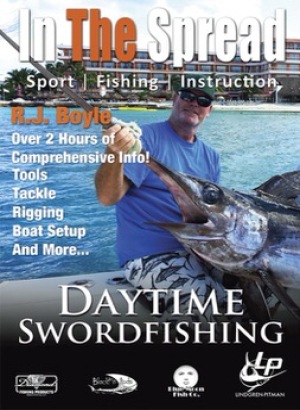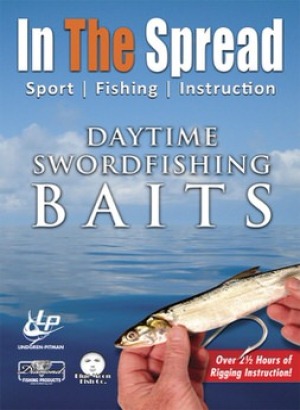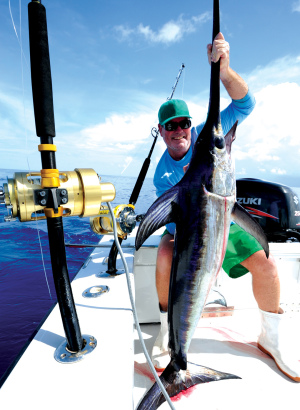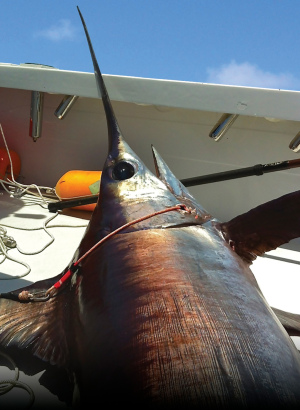Swordfishing has evolved from nighttime tradition to daytime deep dropping techniques. Learn how to target these ocean predators by deploying baits 1,000+ feet deep with specialized gear and tactical boat positioning. Perfect your approach for landing trophy swordfish in challenging deep-water environments.

Swordfishing - The Fine Art of Deep Dropping
Deep Dropping for Swordfish
Gear was deployed with baits suspended at various depths to take advantage of the swordfish that came near the surface to feed. In the last few decades, research and catch reports have brought to the fore a better understanding of swordfish behavior and opened up an ever expanding opportunity to target and routinely catch fish in the daytime.
Like any other oceanic predator, swordfish will be where the food is located. Analysis of the stomach contents of swordfish from around the world indicate that cephalopods account for a large percentage of the diet of this predator. There are a variety of animals within the cephalopod family with squid being the most well known among fishermen. Other fish like, sardines, bullet tuna and various mackerel are also found, to lesser degrees. If swordfish are feasting on squid, you need only account for the movements of squid to understand why swordfish are were they are in the water column, typically.
Vertical Movements of Swordfish
Swordfish are among the few fish species known to traverse extreme thermal barriers on a daily basis, spending prolonged periods hunting both at the surface at night and at great depth during the day. This daily pattern provides swordfish with a unique foraging opportunity that allows them to feed on rich prey resources both during the day and at night. Why are swordfish traveling from the extreme depths to near the surface on a daily basis to feed, anyway?
Swordfish follow what scientist call a diurnal migration. That is, they migrate twice a day. During the day swordfish spend there time feeding on the bottom, and at night they ascend through the water column to feed on squid and fish who are following up plankton. This daily migrations means that there are two very different methods of swordfishing, one during the day and one at night.
To further understand the vertical movement patterns of swordfish, look to their favorite food source, squid and other cephalopods. Cephalopods feed on zooplankton, the building blocks of the food chain in the oceans. Every day, zooplankton make their way to deep water in the morning and rise as the sun sets. This process, known as diel vertical migration, is carried out all over the world by marine and freshwater plankton alike. The reason for this has long been attributed to the trade-off between obtaining tasty morsels in the surface layer of the ocean and avoiding becoming a tasty morsel for predators while they're there.
This mass of zooplankton is commonly referred to as the Deep Scattering Layer. Mixed in with this mass of zooplankton are the squid and baitfish that that feed on the plankton. Being such a rich source of food, it is easy to understand why larger and larger predators would avail themselves to this bevy of food. As the deep scattering layer migrates shallower at night to feed and deeper during the day for safety, a hoard of bait moves with it. This is the driver that dictates the depths where swordfish feed around the globe.
Structure and Bait
Find the bait, find the fish. It seems simple and it is. Baitfish are always going to seek the protection of structure or darkness. At depth, baitfish will hold to natural formations like seamounts, rock piles, ledges, anything that provides refuge. In the Gulf Stream, the current moves at a relatively swift rate, averaging 3.5 knots per hour. This means anything suspended in the current is either moving with the current or it is fighting the current to hold position. Bait is going to be swept along creating a conveyor belt of food for swordfish that hold tight to structure in the daytime. It is just like a trout in a stream. If you have ever watched a trouts behavior, they will slip in and out of the current to snag food. No larger fish wants to fight the current.
When you start to compare the bottom topography of where numbers of swordfish are caught, you will notice common traits. You will see what appears to be significant structure. Things like seamounts, ridges, ledges, depressions, anything the can provide sanctuary or an ambush point is what swords prefer. This principle holds for any fishery. Fish, especially billfish, will pursue food, but they will seek pockets of slack water or solid structure to keep from expending energy fighting the current. If the structure and the current mix in a way the food is carried to, over or around the structure, even better. Think about sitting and watching your favorite sporting event. If you could just kick back and a conveyor belt brought burgers, nachos, beer, milk shakes or whatever you enjoy past and you didn't have to get up to grab something tasty, you wouldn't move much, for a while. This is how predator fish behave.
Swordfishing is all about finding productive bottom structure. Today's electronics make this so much easier, allowing you to scan the bottom to find structure, at even extreme depths. You can also see accumulations of bait. It will be those irregular bottom contours that provide opportunities for swordfish to ambush bait. The currents that sweep over good seafloor topography, create eddies and crosscurrents that trap bait. If you work these points of structures, they will provide consistent swordfishing action.
Swordfishing Techniques
From a technical perspective, nighttime swordfishing is a bit more straight forward than daytime. You drift a mixture of baits in the upper water column, suspending them at depths from 50 feet to 400 or thereabouts. You could get bites deeper. How you drift depends on the current in your area. The hardest part of nighttime swordfishing is having to go to work the next morning. If you struggle catching swords at night, you will probably give up because it was tough to recover from. Fishing all night can be brutal.
The popularity of daytime swordfishing has exploded despite having to drop baits 1500-2000 feet to the bottom. Daunting though it may seem, once you figure out how not to tangle you line as it descends, you will be bouncing baits off the bottom in practice ease. Don't get me wrong. A lot of fishermen struggle with this. Because a heavy lead is required to get you bait down, there is the chance your leader will wrap around main line and fetch up your bait presentation. How you prevent that is with a controlled dropped.
Bonus Video: Swordfishing - Techniques for Hand Crank with RJ Boyle
Expert swordfish angler RJ Boyle shows you how to set up bait, drive the hook, and haul in swordfish. By covering tackle, hook drive, deployment of breakaway rigs, and catching the fish, he enables fishermen to visit swordfish grounds with confidence and improve their fishing techniques. View Short Trailer Below or Learn More Here
Dropping Baits to Swordfish
Daytime swordfishing requires dropping baits to extreme depths, to reach the fish where they are feeding. Once you hit the bottom with your lead, you want to crank it up to stay just a couple hundred feet off the bottom. Deep dropping baits well over 1500 feet to the bottom requires a heavy weight, upwards of 10lbs depending on currents and upwellings. Some anglers use a breakaway weight and some use a stick lead attached to the line with a long line clip. How you get your presentation to the bottom is all preference. When dropping baits, it is critical that you know exactly where your bait is in the water column at all times. Your leader and weight should be set up so that everything is streamlined to prevent tangling. If a bait is tangled in the leader or gets wrapped with the mainline, your efforts are in vain. Your presentation is virtually useless.
Dropping baits to swordfish is a methodical process. The idea is to very deliberately pay out line as your boat is under power, in order to stretch out your rig, letting the weight slowly descend, pulling the bait down along. You should periodically stop the drop to allow more stretch. If you want to see how all of this works, check out our Daytime Swordfishing video. It Demonstrates how you do this and how the rig looks going down. You will let the line out this way until you reach the bottom, at which time you will drive back in the direction of the line until the line off you rod tip is straight up and down.
Current or the lack thereof determines the exact way in which you drop baits. It is all about keeping your rig from getting tangled.
Seth Horne, In The Spread CreatorWith no current, you will need to drive a course in the shape of a C, as you play line out. Low current allows you to drop, while driving with the current and then move your bait up and down in the water column, as you slowly drive to your spot. In the low current scenario, you want to the line scoped out behind the boat. In other words, keep some angle in the line coming off the rod. As the line starts to come more straight up and down, let some line and drive the boat forward. Think of this a bottom jigging. With S. Florida type current, things get more complicated. You will drive with the current until you feel like you're stretched out enough and then you will go to free spool, dropping the bait to the bottom. As you go to free spool, you will turn the boat into the current and drive back up the line until it is straight up and down. Facing into the current, you will be trolling backwards, as you stem the tide. The current pushes you boat backwards, as you stem you speed by slowly bumping in and out of gear. This helps you stay up and down relative to the line coming off your rod tip.
The Drift
Whether you are dealing with current or not, the idea is to cover ground, as you move your bait up and down a hundred or so feet off the bottom. With current, your boat is being swept along and your job is to manage how fast you move. You can do this by stemming the tide. In the Northeast canyons or the Gulf of Mexico, where there is much less current, you will bump troll at your desired speed. In whatever conditions you find yourself, you want to make time over the bottom.
If you are using a bottom machine the maps the seafloor topography, you will notice that a lot of bites come on the backside of the structure. The swordfish lie in wait for prey to be swept by in the current. You can watch this behavior in almost any predator that lives in current. Working structure requires precise coordination between captain and angler. Communication will be key, to ensure your bait is near the bottom as you move past structure, but not so close that you get snagged.
For daytime swordfish, most captains use one of these two basic techniques, driving into a strong current or bump-trolling in light current to cover territory.
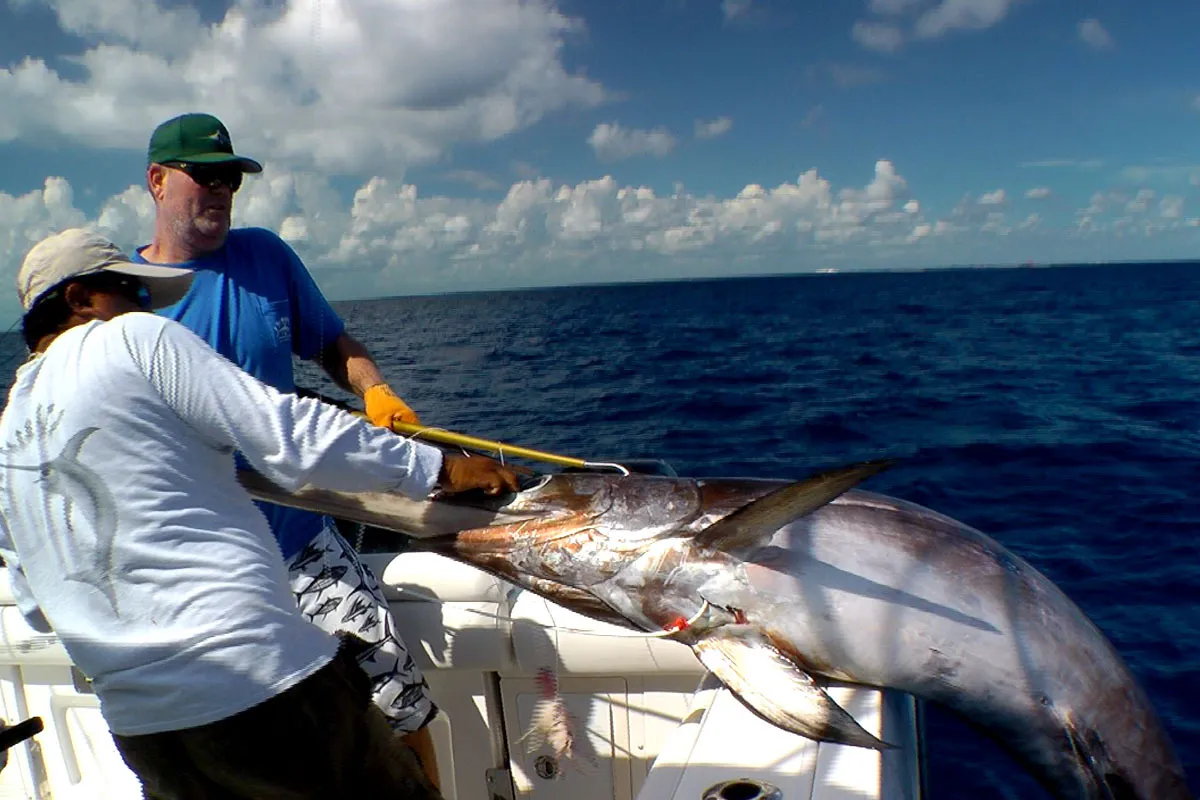
Swordfish Baits
The last thing between you and a fish 1,000 to 2,000 feet away, or more, is your bait. Finer quality baits and bait rigging techniques win out over poorly rigged baits. Swordfish have incredible eyesight. Their advanced eyes allow for exceptional vision, even in the dark of the depths. Their vision is the best of all billfish and perhaps out of all pelagic species. Their ability to detect bait in the deep, as a result of bioluminesence, is uncanny. Even from a good distance away, swordfish know you bait is there. If a bait looks too generic or unappealing, they will avoid it. However, if you rig right, you will get tight.
Whether you are fishing with squid, belly strips, or other dead baits, presentation is critical to enticing a swordfish to bite. How you rig your swordfish baits is a huge determinant. Swordfish are known to attack a bait repeatedly before eating it, so you need something durable. If you bait come to pieces after the first attack, you are finished. Finely sewn baits last longer and allow for multiple shots from the sword. This is especially key when you may not even notice the bite.
If you want to learn more about swordfish bait rigging and how to rig specific baits, check out our Broadbill Swordfish Bait Rigging video. You will learn how to rig baits like squid, ladyfish, mullet, dolphin belly, tinker mackerel, bonito belly and more.
The Swordfish Bite
You would think the bite from a swordfish would be a savage attack, reflecting in wild movements from your rod. To the contrary, the bite of a huge daytime swordfish is very light. At times, it is almost imperceptible. The angler might see the rod tip barely twitch. Given the fish may be whacking at the bait and not gobbling it down and running off, to the untrained eye, the subtle movement of the rod tip may go unnoticed. When you combine the motion of the ocean and the rocking of the boat, many swordfishing newbies never see it.
Since swordfish will try a bait by swatting it, if you miss the bite and the bait just stays in place, the sword may swim off. Part of getting the swordfish fired up entails moving the bait up or down, as if it is fleeing the scene of the attack. In our swordfishing videos, we will show you what to look for and how to react.
Learn More about Swordfishing
There is a lot the goes into swordfishing. The boat setup, the harpoons, the rods and reels, baits, the fuel cost, snacks and beverages, having a good crew that communicated well are all factors that you must deal with. Having the right knowledge on how to catch swordfish makes all the difference. What we do at In The Spread is provide you with access to the experience and knowledge of some of sport fishings very best fishermen. If you want to improve your skillset of are just getting started, we have a collection of Swordfish Fishing Videos that will put you on the path to success. Take the time to acquire all the knowledge you can and go get tight.
Seth Horne In The Spread, Chief CreatorUser Reviews


